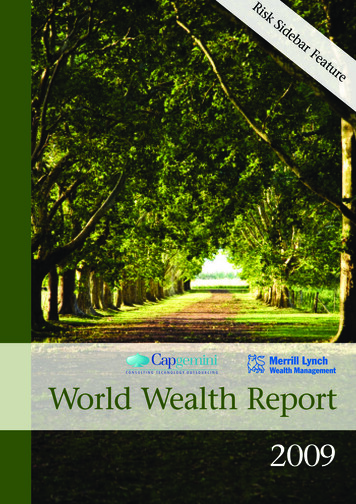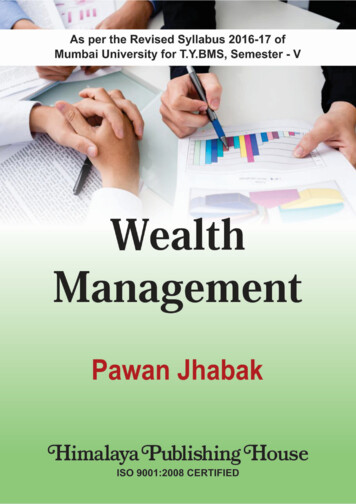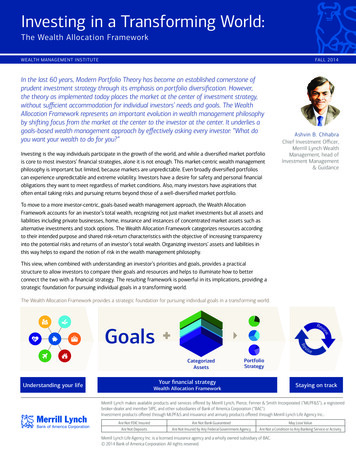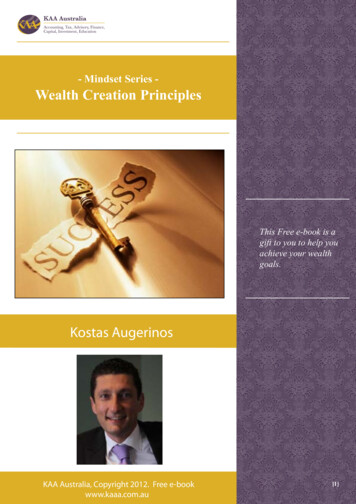
Transcription
RiskSidebarFeatureWorld Wealth Report2009
World Wealth Report 2009Firms Can Act toRebuild ShakenInvestor ConfidenceThrough more HolisticRisk ManagementThe dramatic downturn in 2008 severely shook the confidenceU.S. Treasuries and certain structured products into aof HNWIs in the ability of traditional risk management“fixed-income” bucket. Even when such products werepractices to mitigate their downside exposure. Wealthcomparable from a credit-ratings standpoint, some keymanagement firms acknowledge confidence is shaken, butinherent characteristics, such as liquidity, potential down-many still underestimate how the erosion of trust has andcould affect client relationships.To assuage HNWI concerns and restore their confidence,firms may need to re-evaluate how best to align their clients’financial/risk profiles and personal goals with their truerisk appetites. This will likely involve improving firms’ duediligence practices, and building more comprehensive riskassessments.side and complexity, were different. W eaknesses in due diligence and risk assessment practicesalso came to the fore, negatively impacting clients, when itappeared many firms had failed to recognize market fraud.For example, in the aftermath of various high-profile globalfraud cases, such as the Ponzi schemes perpetrated byBernard Madoff ( 65 billion) and Allen Stanford ( 8 billion),some clients discovered they had been exposed to theseschemes via their Advisors without even realizing it. This issuemay have demonstrated a lack of watchfulness and communi-2008 Prompted HNWIs to Questionthe Strength of Portfolio RiskManagement PracticesThese issues confirm the need for due diligence of products toRisk management frameworks are deployed at many levelsbe done by an independent assessment group to help ensurein financial institutions—from the enterprise-wide to thethe risk profile of products is thoroughly evaluated.product levels—but we are largely talking here about theframeworks that apply to HNWIs individuals, their personal risk profiles, and the portfolio-construction process. Theunprecedented events of 2008 rattled investors in general,but the following issues (separately and together) served inparticular to undermine HNWIs’ trust and confidence in theadequacy of wealth management firms’ due diligence and riskpractices in assessing and managing their portfolio risks:cation by some wealth management firms and Advisors.Our research84 confirmed the extraordinary circumstancesof the crisis negatively impacted perceptions of firms’ duediligence and risk management practices. Both Advisors andHNWI clients ranked risk management and product duediligence capabilities as one of the top reasons clients choseto stay with or leave a wealth management firm in 2008.Nevertheless, many Advisors underestimated that very clientneed. Of HNWI clients surveyed, 73% said risk management The widespread investment losses incurred by firms aroundand due diligence capabilities were an important factor inthe globe eroded confidence in financial institutions—mosttheir decision to stay with their firm in 2008, while only 54%of which were struggling to manage their own portfolios,of Advisors said it was a reason clients did and would stay.and swallow massive write-downs. Many firms, it transpired, had failed to assess and fullyconvey to clients the implications of product risks. HNWIclient portfolios suffered as products and asset classes failedto behave as anticipated—in outright performance, andcompared to the risks implied in their credit ratings. Forinstance, some firms lumped together an extensive rangeof diverse products into a single category, such as putting Research compares responses to the same question in the Financial Advisor and ClientSurveys—see methodology84Moreover, many wealth management executives overestimated the quality of their firm’s due diligence and riskmanagement capabilities. For instance, when asked aboutthese processes, 50% of surveyed executives said they weresatisfied with the current quality, compared to 40% ofAdvisors. This may be because executives believe that theirfirms execute their risk processes diligently, but thatthe analyses themselves are overly simplistic, resulting27
28World Wealth Report 2009in a systemic failure to deliver investor risk profilestrends to personal events like loss of income. This assessmentof the quality sought by clients and Advisors. For example,should go beyond traditional measures such as standardsomebasicdeviation, to provide a detailed picture of extreme scenarios,profiling categories that peg an individual’s risk toleranceincluding potential cumulative losses over a period of time.somewhere on a scale from “Aggressive” through “Moderate”Moreover, scenario analysis can leverage elements fromto “Conservative”. A more comprehensive risk assessmentbehavioral finance to show clients the potential dollarwould help them understand client risk appetites on a faramount at stake whether a position’s value goes up ormore granular level.down. This is especially helpful because evidence suggestswealthmanagementfirmsonlyemployFirms clearly need to close any gaps between perceptionand reality as to risk and due diligence capabilities—both byimproving those processes, and by doing a better job ofcommunicating to clients the specific risk implications ofdifferent products, and the risk-weighted role played bysuch products in a given portfolio. The need to understandthe risks of each product, and communicate the implicationsthoroughly to clients, could be especially challenging forAdvisors who use open product architectures with access toa wide variety of products from different sources.Comprehensive Risk Assessments areFundamental Going ForwardIn the last two downturns, the portfolios of HNWIs whohad gone through a comprehensive risk assessment faredbetter than those of HNWIs who did not. Research shows, forexample, that during the 2000-02 technology bubble downturn the portfolio of a HNWI who completed a comprehensiverisk assessment would have lost 6.1%, whereas a moreconventional risk assessment for the same HNWI wouldlosses elicit a far greater negative reaction in investorsthan the positive reaction produced by gains of the samemagnitude.3. Deeper diversification refers to an exhaustive andgranular analysis of a wide range of asset categories andproducts, which avoids generalization and increases thetransparency in the client portfolio. Diversification shouldoccur not just along asset classes, but within asset classes.For example, this type of approach can draw a distinctionbetween the role of “fixed income” in a portfoliodesigned to generate future returns vs. one designed topreserve capital. Moreover, deeper diversification shouldgenerally be better able than a random set of overlappinginvestments, or even a portfolio allocation model, tocreate a truly diversified portfolio. For instance, it couldbe said that virtually any equity portfolio lost money in2008, regardless of its regional, company size or industryfocus, while deeper diversification helped investors whoalso had solid allocations in gold and U.S. Treasuries tocushion the losses.have resulted in a 15.1% loss.85 Similarly, HNWIs who tookThese elements can lay the foundation of a holistic riskadvantage of a comprehensive risk assessment in 2008assessment, which also incorporates a thorough understandingsuffered smaller losses than those HNWIs who did not.86of clients’ financial and personal goals. Accordingly, a clientA comprehensive risk management assessment can becharacterized by three key elements:might initially identify him or herself as a “Moderate/Aggressive” investor, but might reconsider their positionafter learning the potential portfolio impact of a confluence1. Behavioral finance is a relatively new field that encom-of events like loss of income along with unexpected marketpasses “soft” factors, such as the emotion around economiclosses. As a result, the investor might put more emphasis ondecisions—emotion that is known to skew perceptionscontaining personal risk, and less on pursuing returns (whichabout risk. Behavioral-finance approaches provide a moremay also involve more risk). This shift would clearly changecomplete picture of the way clients make investmentthe Advisor/firm approach to portfolio design and executiondecisions. This provides a richer level of detail that makesfor that HNWI.it possible to go beyond the traditional “Conservative”,“Moderate”, and “Aggressive” portfolio-model labels oftenused for individuals.2. Scenario analysis can be used to assess and communicateto clients, in a thorough but simple way, the potentialimpact of extreme scenarios on a portfolio —from market85 Chhabra, Ashvin, “Beyond Markowitz – A comprehensive Wealth Allocation Framework forIndividual Investors”, Merrill Lynch. 2005 Christopher Wolfe, Managing Director, Merrill Lynch. Interview by Capgemini, April 2009.86Additionally, looking at client risk by portfolio value aloneis probably not sufficient. Understanding the client risk intotality, at their total wealth level is also important. Clients’liquidity needs, income requirements, time horizons, risktolerance need to be integrated into the full risk assessmentalong with performance expectations.
World Wealth Report 2009uSING HOLISTIC RISk ASSeSSMeNTS CANADDReSS CLIeNT RISk PROFILeS IN AMORe INNOvATIve WAyand a proper risk-appetite appraisal—in the context of theclient’s total level of wealth. Investment advisory process, i.e., creating an ongoingUltimately, then, holistic risk assessment can directly driverelationshipthe portfolio-construction and investment advisory-processperformance—not just of the portfolio itself, but against the(see Figure 18).client’s total wealth picture, so adjustments can be madeThe HNWI’s appetite for personal, market, and aspirationalrisk are weighed against their precise goals and needs—afterfull disclosure of the potential risks and dollar impact of e.g.,a confluence of events or extreme scenarios.withtheclienttomonitorportfoliofor changing life events and needs, and evolving marketconditions.Several wealth management firms are already leading theindustry in helping their HNWI clients to understand theirtrue risk tolerance through these kinds of deeper assessmentA thorough holistic risk assessment could help ensure theprocesses. These innovative processes help firms to understandsubsequent, inter-related phases of the portfolio-managementhow clients emotionally process and make decisions aboutand individual risk profiling process will be more effective.preserving, maintaining, and growing their investments.Those basic stages are:By participating regularly in holistic risk assessments, Broad and deep asset allocation, i.e., finding the mostHNWIs are likely to feel a far greater level of confidence in thesuitable combination of a wide range of asset classes andrisk management and due diligence practices at their wealthproducts therein, given the holistic risk assessment.management firm. They will also be better informed, and Portfolio construction, i.e., allocating investments tomore qualified to participate directly in creating their ownspecific products whose risks and function the clientpersonalized investment strategy. For wealth managementfully understands. The Advisor or investment-team role isfirms, then, stronger and more comprehensive risk assessmentsessential in helping ensureare a cornerstone of regaining HNWI client trust.the selection is done in astrategic way, in line with deep diversification processes,HolisticClientRiskAssessmenta CoreElementof icFigureClientRiskAssessmentas aasCoreElementof OngoingClient-AdvisorInteractionHOLISTIC CLIENT RISK ASSESSMENTONGOING CLIENT-ADVISOR INTERACTIONIndividual Goals and NeedsCash flow needsOther assetsFinancial assetsNet worthAbility to weathershortfallsRegionalpreferencesEvent riskLifecycle stageBroad / DeepAsset AllocationHolisticClient RiskAssessmentAligning risk exposure to goals and te: “Protect” goal refers to client desire to minimize losses in falling markets; “Maintain” goal is to minimize risk during unremarkablemarketsusinggoala deeplydiversified portfolio);is toinmaximizereturns in“Maintain”rising markets*Note: (e.g.,“Protect”refersto clientdesire to“Improve”minimizegoallossesfalling markets;goal is to minimize risk duringunremarkable markets (e.g., using a deeply diversified portfolio); “Improve” goal is to maximize returns in rising marketsPortfolioConstruction29
2009 Capgemini and Merrill Lynch Global Wealth Management. All RightsReserved. Capgemini and Merrill Lynch Global Wealth Management, theirservices mentioned herein as well as their respective logos, are trademarksor registered trademarks of their respective companies. All other company,product and service names mentioned are the trademarks of their respectiveowners and are used herein with no intention of trademark infringement.No part of this document may be reproduced or copied in any form or by anymeans without written permission from Capgemini and Merrill Lynch GlobalWealth Management.Disclaimer:The information contained herein is general in nature and is not intended,and should not be construed, as professional advice or opinion provided tothe user. This document does not purport to be a complete statement ofthe approaches or steps, which may vary accordingly to individual factorsand circumstances, necessary for a business to accomplish any particularbusiness goal. This document is provided for informational purposes only;it is meant solely to provide helpful information to the user. This documentis not a recommendation of any particular approach and should not be reliedupon to address or solve any particular matter. The information providedherein is on an “as-is” basis.Capgemini and Merrill Lynch Global Wealth Management disclaim any andall warranties of any kind concerning any information provided in this report.For more information, please contact: wealth@capgemini.comFor Capgemini press inquiries, please contact:Lisa Desmond at 1-786-251-8413 (North America) orKaren Cohen at 1-516-607-9652 (Global)For Merrill Lynch press inquiries, please contact:Selena Morris at 1-212-449-72830,000 trees were left standing as a result of therecycled paper used in this project.0,000 gallons of water were saved.0,000 pounds of global warming gases were avoided.0,000 kilowatt-hours of energy were saved(8,200 kWh of energy can heat and cool an averageAmerican home for one year). 000 cubic feet of solid waste were kept out ofa landfill. Design and Layout: ZENITH COLOR COMMUNICATION GROUP INC. 2007 Green PrintCover Photo: Picturegarden, The Image Bank/Getty Images. All rights reserved. 2009, Merrill Lynch, Pierce, Fenner & Smith Incorporated and Capgemini. All rights reserved.202 trees were left standing as a result of therecycled paper used in this project.10,070 gallons of water were saved.16,638 pounds of global warming gases were avoided.23,879 kilowatt-hours of energy were saved(8,200 kWh of energy can heat and cool an averageUS home for one year). 389 cubic feet of solid waste were kept out ofa landfill. 2007 Green PrintCert no. SGS-COC-2807
diligence and risk management practices. Both Advisors and HNWI clients ranked risk management and product due diligence capabilities as one of the top reasons clients chose to stay with or leave a wealth management rm in 2008. Nevertheless, many Advisors underestimated that very client need.











